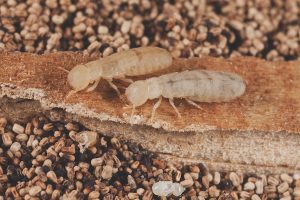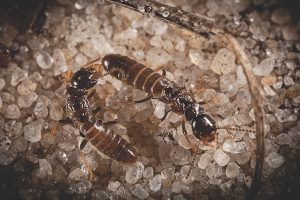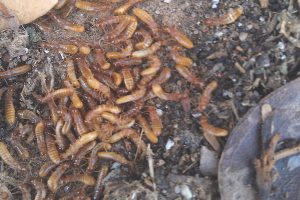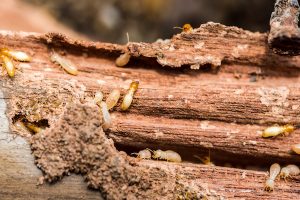March 13-19th is National Termite Awareness Week, and for good cause too. Termites cause more than $5 billion in property damage in the US every year! Though they’re usually associated with tropical climates, termites have been a big problem for Michigan’s forests and homes for a long time. The most common termite in Michigan, the Eastern Subterranean Termite (Reticulitermes flavipes), is by far the most destructive wood pest in the state.
Considering the property damage and danger they pose, it’s easy to see why a National Termite Awareness Week is important. To do our part, Griffin has put together this primer on the termites of Michigan. Here’s everything you need to know to protect your home from the wood-munching monsters: how termites work, what attracts them, and how you can keep them out.
 What They Are
What They Are
Termites are an insect classified in the same family as cockroaches. Like bees or ants, they live together in large, eusocial colonies. These colonies are made up of three “classes” of termite: workers, soldiers, and the reproducing “king” and “queen.” Only worker termites eat wood and cause property damage… though you don’t want soldiers or reproducers around, either.
Worker termites and are white and measure about ¼ of an inch long. Soldiers are a similar size but have longer heads and jaws. The “king” and “queen” termites are dark brown or black, and measure ⅜ to ½ of an inch long. They’re solely responsible for repopulating the colony, so any pest control targeting termites should prioritize getting rid of this termite “royalty.”
Termites only leave their colonies to mate. Young termite reproducers pair off and form swarms, and then search for suitable places to live. When a desirable location is found, the “King” and “Queen” excavate a mating chamber and proceed to start a new colony. In early stages, Queens can only lay 10-20 eggs, but if the colony takes off, they may lay up to 1000 eggs a day!
 Why They Infest Houses
Why They Infest Houses
Termites are famous for eating wood, including the wood used in manmade structures. This diet helps termites get all of the resources they need to complete their growth and mating cycles. Wood from homes provides them with cellulose, sugars, and starches. Termites can even derive all the protein they need from eating moist wood, which is part of why they’re partial to wet or humid places.
Along with wood to eat, termites require moisture, warmth, and shelter. Colonies often flock to homes because they can provide all of these. After eating, termites have to return to soil to refresh the moisture they lose. They build elaborate tunnel systems through wood and dirt, leading between outside and inside. Colonies typically live in hollowed-out spaces connected to their tunnels.
 Why They’re a Problem
Why They’re a Problem
Single worker termites can’t eat much on their own, but whole colonies can eat an astounding amount of wood, and they can get to structures more capably than you’d expect. Slowly but surely, termite damage can compromise your home’s structural integrity.
Enough damage could necessitate an expensive home renovation, and could even be dangerous! In extreme circumstances, termite colonies have done so much damage to a house’s structural foundation that the structure had to be condemned and demolished! Termites also go after wooden furniture. A termite infestation can ruin chairs, tables, floors, and decor. Of all the pest infestations, termites colonies tend to be the most costly.
 How You Can Prevent Them
How You Can Prevent Them
The trick to keeping termites away is to deprive them of the resources they need. Termites burn through a lot of their moisture chewing through wood. Pretty much the only time they stop eating is when they return to wet soil. If you can make sure your attic and basement stay dry, they won’t be as attractive as colonization sites.
The next step to termite protection is simply keeping wood safe. Make sure there’s a barrier of some kind between soil and wooden substructures. Treat any of the wood you can, especially wooden furniture. Store woodpiles on shelving, not the ground. Fix any rotting or plumbing leaks you find quickly. If your garden uses mulch, make sure it’s not cellulose-based. Seal cracks in your foundation, windows, insulation, and exterior walls.
For more ideas on where to start, check out our blog from 2015’s termite awareness day, our blog on combating Michigan’s most pervasive pest problems, or our termite pest control focus page. Remember: no matter how bad the problem, you have resources and options. You can do something about it.
How We Can Stop Them
If you do happen to end up with a termite infestation, call us right away. Griffin’s Termite Protection Program combines the latest science with a customized action plan, designed to your particular problem, needs, and specifications. Not only will we end your current infestation, we’ll help make sure termites can’t get in again.
If you have any more questions about termites, or if you think you may have an infestation, get in touch anytime. The faster you can drive those wood-munchers out, the more money you’ll save in the long run, so don’t hesitate!



